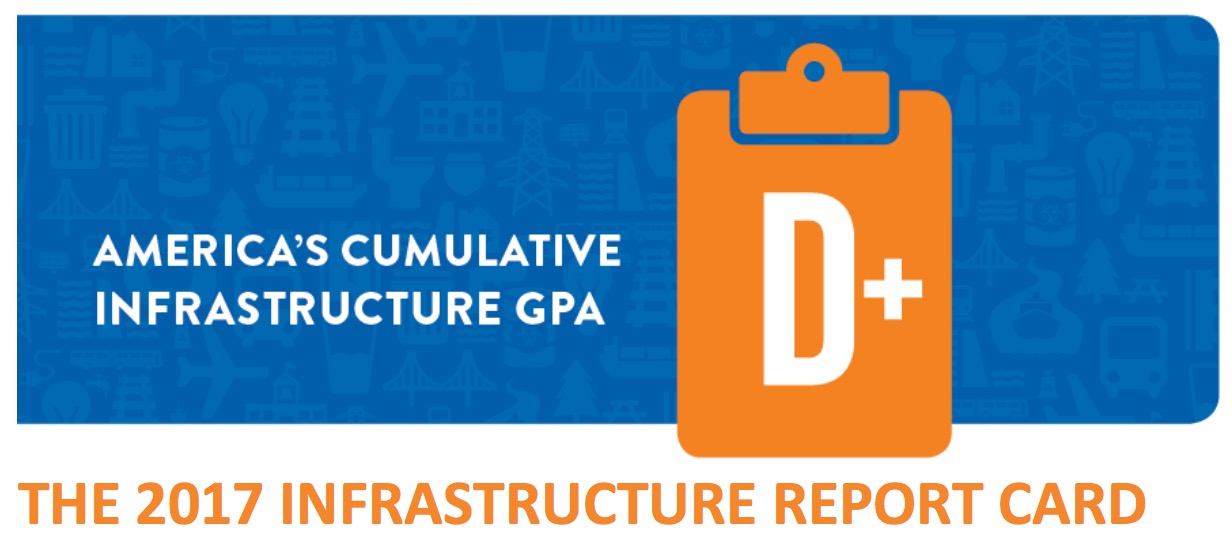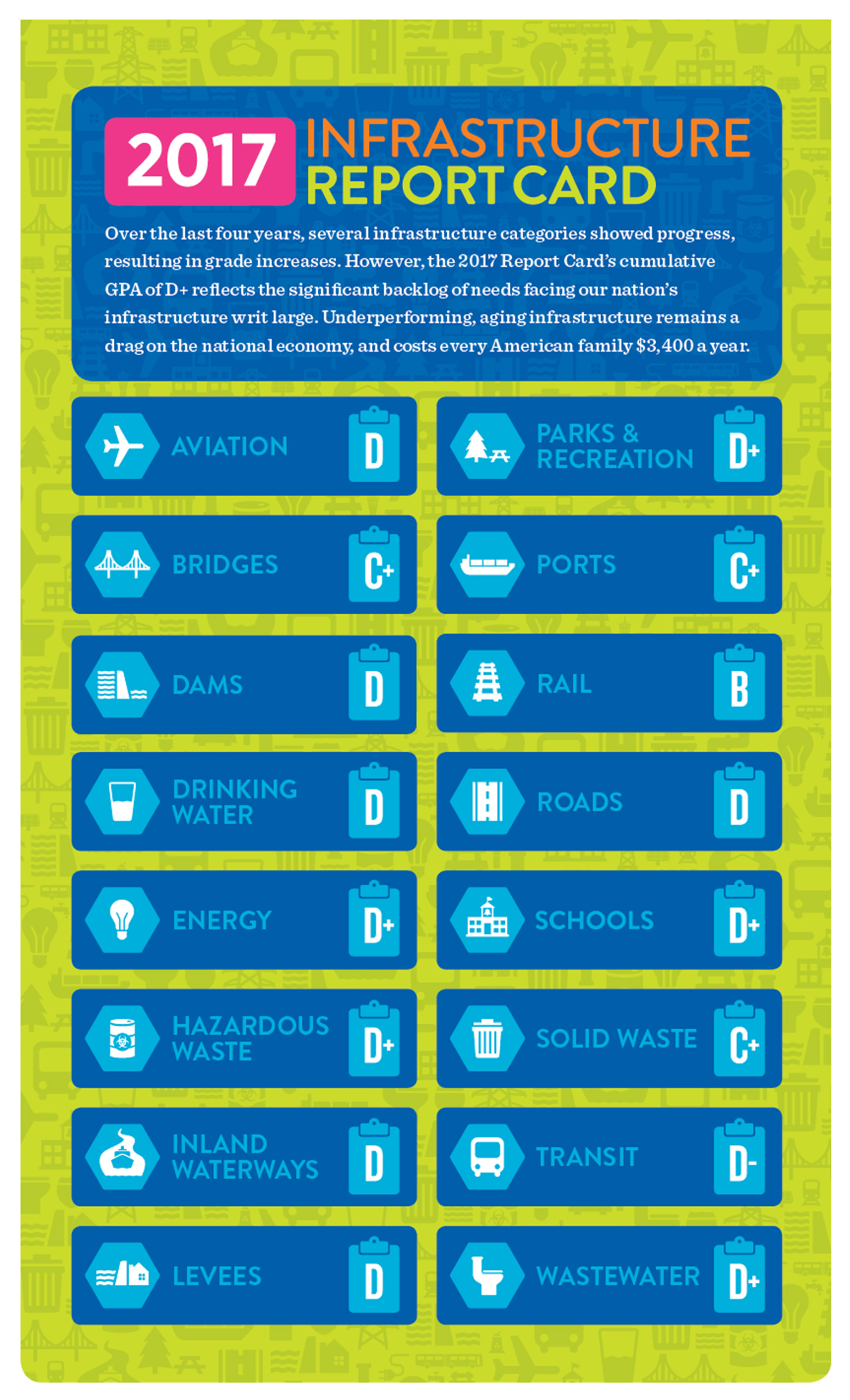AMERICAN SOCIETY OF CIVIL ENGINEERS (ASCE)
A COMPREHENSIVE ASSESSMENT OF AMERICA’S INFRASTRUCTURE
Introduction
Our nation is at a crossroads. Deteriorating infrastructure is impeding our ability to compete in the thriving global economy, and improvements are necessary to ensure our country is built for the future. While we have made some progress, reversing the trajectory after decades of underinvestment in our infrastructure requires transformative action from Congress, states, infrastructure owners, and the American people.
Our nation’s infrastructure challenges are significant but solvable. Through strategic, sustained investment, bold leadership, comprehensive planning, and careful preparation for the needs of the future, America’s infrastructure will be improved and restored.
For the U.S. economy to be the most competitive in the world, we need a first-class infrastructure system — transport systems that move people and goods efficiently and at reasonable cost by land, water, and air; power transmission systems that deliver reliable, low-cost power from a sustainable range of energy sources; and water systems that protect public health. To achieve this, leaders on both sides of the political aisle need to make good on promises they have made to improve our nation’s infrastructure and ensure these pledges don’t fall by the wayside after each election cycle. Infrastructure is the foundation that connects the nation’s businesses, communities, and people, driving our economy, improving our quality of life, and ensuring our public health and safety. Now is the time to renew, modernize, and invest in our infrastructure to maintain our international competitiveness. The longer we wait, the more it will cost.
The 2017 Infrastructure Report Card reveals that we have made some incremental progress toward restoring our nation’s infrastructure. But it has not been enough. As in 2013, America’s cumulative GPA is once again a D+.
The 2017 grades range from a B for Rail to a D- for Transit, illustrating the clear impact of investment — or lack thereof — on the grades. Three categories — Parks, Solid Waste, and Transit — received a decline in grade this year, while seven — Hazardous Waste, Inland Waterways, Levees, Ports, Rail, Schools, and Wastewater — saw slight improvements. Six categories’ grades remain unchanged from 2013 — Aviation, Bridges, Dams, Drinking Water, Energy, and Roads. The areas of infrastructure that improved benefited from vocal leadership, thoughtful policymaking, and investments that garnered results. These improvements demonstrate what can be accomplished when solutions that move projects forward are approved and implemented.
Infrastructure Investment Needs
Infrastructure is the backbone of the U.S. economy and a necessary input to every economic output. It is critical to the nation’s prosperity and the public’s health and welfare. Infrastructure’s condition has a cascading impact on our nation’s economy, impacting business productivity, gross domestic product (GDP), employment, personal income, and international competitiveness.
America’s infrastructure bill is long overdue. Every four years, ASCE estimates the investment needed in each infrastructure category to maintain a state of good repair and earn a grade of B. The most recent analysis reveals the U.S. has only been paying half of its infrastructure bill for some time and failing to close that gap risks rising costs, falling business productivity, plummeting GDP, lost jobs, and ultimately, reduced disposable income for every American family.
Even though the U.S. Congress and some states have recently made efforts to invest more in infrastructure, these efforts do not come close to the $2.0 trillion in needs. The good news is that closing America’s infrastructure gap is possible if Congress, states, infrastructure owners, and voters commit to increasing our investment. To raise the overall infrastructure grade and maintain our global competitiveness, Congress and the states must invest an additional $206 billion each year.
As ASCE discovered in its 2016 economic study, Failure to Act: Closing the Infrastructure Investment Gap for America’s Economic Future, failing to close this infrastructure investment gap brings serious economic consequences:
- $3.9 trillion in losses to the U.S. GDP by 2025;
- $7 trillion in lost business sales by 2025; and
- 2.5 million lost American jobs in 2025.
On top of those costs, hardworking American families will lose upwards of $3,400 in disposable income each year — about $9 each day.
The time to invest in our nation’s infrastructure is now. The longer we wait, the more it costs. Investing now will save our country more in the long run while also creating economic opportunity, enhancing quality of life, and ensuring public health and safety.
Download full version (PDF): 2017 Infrastructure Report Card
About the American Society of Civil Engineers (ASCE)
www.asce.org
The American Society of Civil Engineers (ASCE), founded in 1852, is the nation’s oldest 150,000 civil engineers in private practice, government, industry, and academia who are dedicated to advancing the science and profession of civil engineering
Tags: 2017 Grades, American Society of Civil Engineers, ASCE, Infrastructure Report Card, Report Card








 RSS Feed
RSS Feed